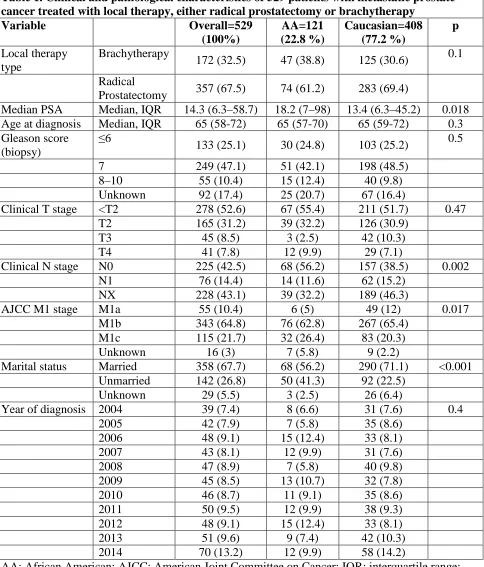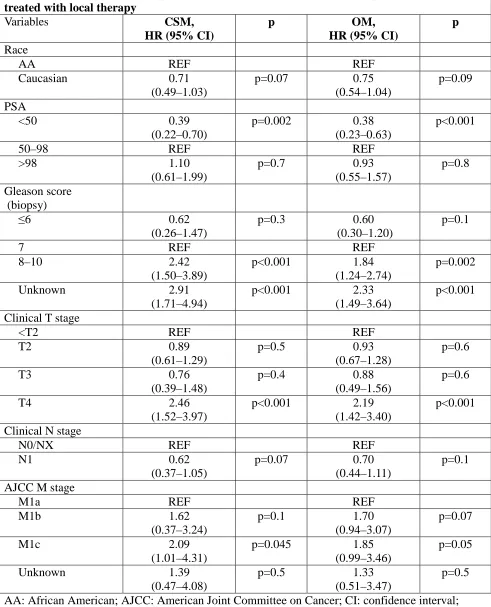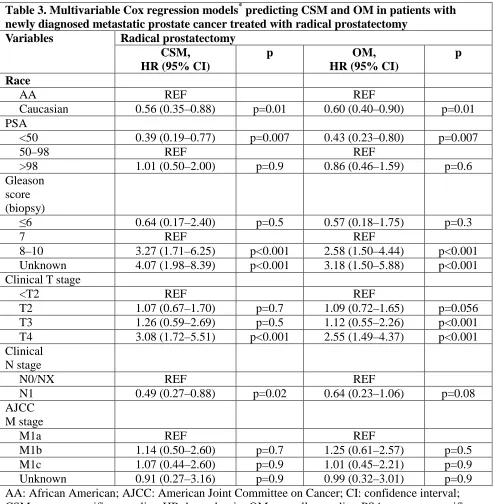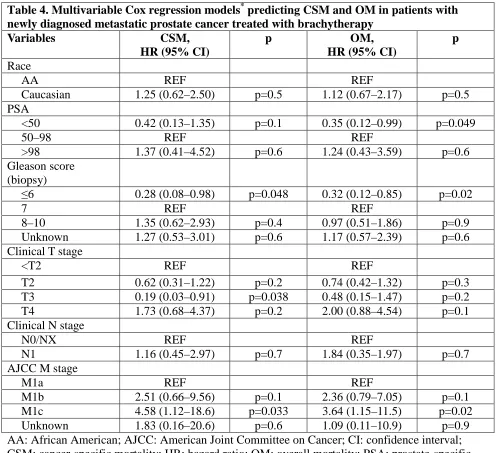The effect of race on survival after local therapy in metastatic prostate cancer patients
Elio Mazzone1; Marco Bandini1,2; Felix Preisser3; Sebastiano Nazzani2; Zhe Tian2; Firas Abdollah4; Denis Soulieres5; Markus Graefen6; Francesco Montorsi1; Shahrokh Shariat7; Fred Saad2; Alberto Briganti1; Pierre Karakiewicz2
1Division of Oncology/Unit of Urology, URI, IRCCS Ospedale San Raffaele and Vita-Salute San Raffaele University,
Milan, Italy; 2Cancer Prognostics and Health Outcomes Unit, University of Montreal Health Centre, Montreal, QC, Canada; 3Department of Urology, Goethe-Universität Frankfurt am Main, Germany; 4Henry Ford Health System, Detroit , MI, United States; 5Division of Medical Oncology/Hematology Centre Hospitalier de l’Université de Montréal, Montreal, QC, Canada; 6Martini-Clinic, Prostate Cancer Centre Hamburg-Eppendorf, Hamburg, Germany;
7Department of Urology, Medical University of Vienna, Vienna, Austria
Cite as: Can Urol Assoc J 2018 October 15; Epub ahead of print. http://dx.doi.org/10.5489/cuaj.5399
Published online October 15, 2018
***
Abstract
Introduction: Local therapy (LT) may offer a survival advantage in highly select newly diagnosed metastatic prostate cancer (mPCa) patients. However, it is unknown whether the benefits vary according to Caucasian vs. African American (AA) patients.
Methods: Within the Surveillance Epidemiology and End Results database (2004–2014), we focused on Caucasians and AA patients with newly diagnosed mPCa treated with LT: radical prostatectomy (RP) and brachytherapy (RT). Endpoints consisted of cancer-specific mortality (CSM) and overall mortality (OM). Kaplan-Meier analyses and multivariable Cox regression models tested for racial difference in CSM and OM.
Results: Between 2004 and 2014, we identified 408 (77.2%) Caucasians and 121 (22.8%) AAs with newly diagnosed mPCa treated with LT: either RP (n=357) or RT (n=172). According to race, when LT is defined as RP, Caucasian patients had a significantly longer survival vs. AA patients: CSM-free survival 123 vs. 63 months (p=0.004) and OM-free survival 108 vs. 46 months
(p=0.002). The CSM and OM benefits were confirmed in multivariable analyses (hazard ratio [HR] 0.56, p=0.01 for CSM; HR 0.60, p=0.01 for OM). However, no differences in CSM or OM were recorded according to race when LT consisted of RT.
Conclusions: Our results indicate that race is not associated with difference in survival after LT in mPCa patients. However, when focusing on RP-treated patients, Caucasian race is associated with higher CSM and OM rates relative to AA race. This racial difference does not apply to RT. Our findings should be considered in future prospective trials for the purpose of pre-planned
Introduction
Local therapy (LT) may offer a survival advantage in highly select patients with newly diagnosed
metastatic prostate cancer (mPCa) according to several retrospective studies [1–10]. Nonetheless, the
retrospective nature of these studies requires prospective validation. Indeed, the ongoing g-RAMPP
trial [11] will provide European data. Similarly, the upcoming SWOG-1802 trial [12] and other trials
will provide North American data. To the best of our knowledge, no ongoing study is sufficiently
powered to allow pre-planned stratification according to race [11,12]. Similarly, we are unaware of
previous studies that examined the effect of race in retrospective analyses.
In the light of these limitations, our goal was to test the effect of race on cancer specific mortality (CSM) and overall mortality (OM) in patients treated with LT, in the context of newly diagnosed mPCa. Specifically, we hypothesized that the survival benefit of LT may be different according to race (Caucasian vs AA), since AA patients may harbour more aggressive prostate
cancer characteristics than their Caucasian counterparts [13–21]. Moreover, we performed separate
analyses for radical prostatectomy (RP) and brachytherapy (RT), based on previously reported
differences in the survival benefit, according to LT type [6].
Methods
Data source and patient selection
The current study relied on the Surveillance Epidemiology and End Results (SEER) database (2004-2014), which samples 26% of the United States and approximates the United States in terms
of demographic composition, as well as of cancer incidence [22]. In the SEER database, we focused
on Caucasian and AA men aged 18 years or older, diagnosed between 2004 and 2014 with
histologically confirmed adenocarcinoma of the prostate (International Classification of Disease for Oncology [ICD-O-3] code 8140 site code C61.9). We only considered patients with newly
diagnosed mPCa. CSM was defined according to the SEER mortality code. All other deaths were considered as other-cause mortality (OCM). LT types available in SEER database consist of: 1) radical prostatectomy (RP) (surgery site codes 50 and 70) with or without external beam radiation
therapy (EBRT) or (2) RT (ie, brachytherapy) with or without EBRT [6]. Brachytherapy was
defined as prostate-directed radioactive implants with ("Combination of beam with implants or isotopes" according to “Radiation.recode” SEER variable) or without ("Radioactive implant" or “Radioisotopes” according to “Radiation.recode” SEER variable) combined administration of EBRT. EBRT was excluded due to the lack of data regarding target site that allows to distinguish
local from extraprostatic treatment [6]. Other surgical treatments than RP were also excluded, as
described earlier [6]. These selection criteria yielded 529 patients, who were addressed in overall
analysis of the effect of LT (RP and RT) according to race. Subsequently, analyses were repeated according to LT type: one set of analyses focused on RP patients and another set of analyses focused on RT patients.
Statistical analyses and covariates
[M1a, M1b, M1c]) [23]. Medians and ranges were reported for continuously coded variables (age and PSA). The statistical significance of differences in medians and proportions was tested with Kruskal-Wallis and chi-square tests. All statistical tests were two-sided with a level of significance set at p < 0.05. Analyses were performed using the R software (version 3.3.0;
http://www.r-project.org/).
Results
General characteristics of the study populations
Overall, we identified 529 men with newly diagnosed mPCa treated with LT between 2004-2014. Of these, 408 (77.2%) were Caucasian and 121 (22.8%) were AA. AA patients had higher median PSA level at diagnosis (18.2 vs. 13.4 ng/ml, p=0.018) and were more frequently unmarried (41.3% vs. 22.5%, p<0.001) than Caucasian. Median age at diagnosis was virtually the same between the two groups (65 years for both, p=0.3). According to clinical AJCC M sub-staging, AAs more frequently harboured M1c stage (26.4% vs. 20.3%, p=0.017). RP was performed in 283 (69.4%) Caucasians and 74 (61.2%) AAs. Similarly, RT was performed in 125 (30.6%) Caucasians and 47 (38.8%) AAs (Table 1).
Survival analyses
In the overall population consisting of RP and RT patients, KM analyses demonstrated CSM free survival of 123 months for Caucasians versus 117 months for AAs (p=0.1). Similarly, OM free survival was 82 months for Caucasians versus 57 months for AAs (p=0.07) (Fig. 1A). In multivariable analyses, no differences were reported according to race in model that focused on CSM (HR 0.71, CI 0.49-1.03, p=0.07), as well as in the model that focused on OM (HR 0.75, CI 0.54-1.04, p=0.09) (Table 2).
In patients treated with RP, unadjusted KM analyses demonstrated CSM free survival of 123 months for Caucasians versus 63 months for AAs (p=0.004), and OM free survival of 108 months for Caucasians versus 46 months for AAs (p=0.002) (Fig.1B). In multivariable Cox regression models, stratification according to Caucasian vs AA race resulted in HR 0.56 (CI 0.35-0.88,
p=0.01). Similarly, in multivariable models predicting OM, stratification according to Caucasian vs AA race resulted in HR 0.66 (CI 0.40-0.90, p=0.01) (Table 3).
In RT patients, unadjusted KM analyses showed that median CSM free survival was 82 months for Caucasians and was not reached for AAs (p=0.4). Similarly, OM free survival was 64 months for Caucasians versus 68 months for AAs (p=0.4) (Fig. 1C). In multivariable analyses, no differences were identified according to race in models that focused on CSM (HR 1.25, CI 0.62-2.50, p=0.5), as well as in models that focused on OM (HR 1.21, CI 0.67-2.17, p=0.5) (Table 4).
Discussion
In the context of newly diagnosed mPCa, LT has been shown to improve overall survival in several
retrospective epidemiological analyses [1–6,9,10]. We hypothesized that AA patients may be
associated with lower CSM and OM rates after LT relative to their Caucasian counterparts in the context of mPCa, based on previous evidence suggesting a more aggressive PCa phenotype in AAs [13–18] . We also postulated that the survival benefit from LT may differ according to LT type: RP
versus RT [2,3,6]. To address this hypothesis, we examined the effect of race on CSM and OM in
First, CSM and OM did not differ between Caucasian and AA patients when LT was defined as either RP and RT. Absence of differences was recorded in both unadjusted and fully adjusted analyses. This finding is consistent with previous studies that examined the effect of LT in
the context of mPCa, where LT was defined as either RP and RT [3,6].
However, when LT was defined as only RP, OM and CSM analyses showed important survival differences according to race. Specifically, AA patients exhibited worse survival in both CSM and OM analyses. Subsequent analyses that exclusively focused on RT patients failed to demonstrate racial differences in CSM and OM, in both unadjusted and adjusted models. Taken together, these findings illustrate two important points. Our data suggest that racial differences may be associated with survival differences after LT in the context of newly diagnosed mPCa. Our retrospective observations also suggest that a potential survival benefit according to Caucasian race may only apply to LT defined as RP, but not to RT.
These findings have important clinical implications. Until prospective randomized trials of LT in mPCa context become available with pre-planned stratification according to race, our retrospective analysis seems to show a different association between survival and RP according to race. This recommendation needs to be accompanied by a warning about potential flaws originating from retrospective analyses.
Our findings also need to be considered, when the type of LT is debated in the context of the
mPCa in AA patients. According to previously reported data [2–6,9], RT did show a survival benefit
in retrospective survival analyses focusing on newly diagnosed mPCa. In several of these analyses,
RT appeared to provide a benefit that was of lesser magnitude than that derived from RP [2,3,6]. Our
findings add to the existing evidence and suggest no racial differences in survival, when RT is contemplated. In consequence, until randomized prospective trials examining the effect of LT on survival in mPCa become available, the results of the current analysis may help to better address the use of RP or RT according to race in highly select mPCa patients who are candidate to receive LT.
Second, regarding the survival benefit observed after RP in the context of mPCa, the advantage recorded in Caucasian patients requires special consideration. All analyses relied on two separate outcomes: CSM and OM. In both analyses (CSM and OM), virtually the same results were observed. This observation indicates that RP in newly diagnosed mPCa has a robust beneficial effect in Caucasian patients, when either CSM or OM are examined. Similarities in CSM and OM imply that RP delivered to newly diagnosed metastatic Caucasian patients not only results in more favourable CSM, but also results in more favourable OM (HR 0.56, p=0.01 for CSM; HR 0.6, p=0.01 for OM).
Third, we confirmed the prognostic significance of several established risk variables in newly diagnosed mPCa patients. These variables consisted of biopsy GS, clinical T stage and PSA. These observations confirm the validity of our models with respect to disease aggressiveness, according to stage and grade.
Our study is not devoid of limitations. First, it is affected by its retrospective nature, as
applicable to previous analyses [1–6,9,10]. Second, we are not able to assess the exact extent of the
metastatic disease, despite adjustment for AJCC M1 sub-stages. For example, we had no data regarding specific number or location of metastatic foci beyond the information conveyed by M1
sub-stages. Third, as in several previous analyses [2–4,6], we were unable to adjust for baseline
not available in the SEER registry. Finally, the number of AA patients, who benefited from LT, was limited. This may have affected the statistical significance of our comparisons. However, the
findings regarding racial differences in RP patients were both highly clinically meaningful and highly statistically significant. This implies that sample size did not undermine comparisons of survival according to race in RP patients. Regarding comparisons according to race in RT patients, the sample size was indeed more limited. However, the recorded absolute figures and rates were virtually the same between the two races. This suggests that lack of survival difference in RT patients is unlikely directly related to sample size limitations.
Conclusion
References
1. Gratzke C, Engel J, Stief CG. Role of radical prostatectomy in metastatic prostate cancer:
Data from the munich cancer registry. Eur Urol. 2014;66(3):602-603.
doi:10.1016/j.eururo.2014.04.009
2. Culp SH, Schellhammer PF, Williams MB. Might men diagnosed with metastatic prostate
cancer benefit from definitive treatment of the primary tumor? A SEER-based study. Eur
Urol. 2014;65(6):1058-1066. doi:10.1016/j.eururo.2013.11.012
3. Antwi S, Everson TM. Prognostic impact of definitive local therapy of the primary tumor in
men with metastatic prostate cancer at diagnosis: A population-based, propensity score
analysis. Cancer Epidemiol. 2014;38(4):435-441. doi:10.1016/j.canep.2014.04.002
4. Fossati N, Trinh QD, Sammon J, et al. Identifying optimal candidates for local treatment of
the primary tumor among patients diagnosed with metastatic prostate cancer: A SEER-based
Study. Eur Urol. 2015;67(1):3-6. doi:10.1016/j.eururo.2014.08.056
5. Löppenberg B, Dalela D, Karabon P, et al. The Impact of Local Treatment on Overall
Survival in Patients with Metastatic Prostate Cancer on Diagnosis: A National Cancer Data
Base Analysis. Eur Urol. 2017;72(1):14-19. doi:10.1016/j.eururo.2016.04.031
6. Leyh-Bannurah SR, Gazdovich S, Budäus L, et al. Local Therapy Improves Survival in
Metastatic Prostate Cancer. Eur Urol. 2017;72(1):118-124. doi:10.1016/j.eururo.2017.03.020
7. Gandaglia G, Fossati N, Stabile A, et al. Radical Prostatectomy in Men with Oligometastatic
Prostate Cancer: Results of a Single-institution Series with Long-term Follow-up. Eur Urol.
2017;72(2):289-292. doi:10.1016/j.eururo.2016.08.040
8. Heidenreich A, Pfister D, Porres D. Cytoreductive Radical Prostatectomy in Patients with
Prostate Cancer and Low Volume Skeletal Metastases: Results of a Feasibility and
Case-Control Study. J Urol. 2018;193(3):832-838. doi:10.1016/j.juro.2014.09.089
9. Satkunasivam R, Kim AE, Desai M, et al. Radical prostatectomy or external beam radiation
therapy versus no local therapy for survival benefit in metastatic prostate cancer - a
SEER-Medicare analysis. J Urol. 2015;194(2):378-385. doi:10.1016/j.juro.2015.02.084.Radical
10. Sooriakumaran P, Karnes J, Stief C, et al. A Multi-institutional Analysis of Perioperative
Outcomes in 106 Men Who Underwent Radical Prostatectomy for Distant Metastatic
Prostate Cancer at Presentation. Eur Urol. 2016;69(5):788-794.
doi:10.1016/j.eururo.2015.05.023
11. Impact of Radical Prostatectomy as Primary Treatment in Patients With Prostate Cancer
With Limited Bone Metastases (g-RAMPP).
https://clinicaltrials.gov/ct2/show/NCT02454543?term=NCT02454543&rank=1.
12. Best Systemic Therapy or Best Systemic Therapy (BST) Plus Definitive Treatment
(Radiation or Surgery).
https://clinicaltrials.gov/ct2/show/study/NCT01751438?term=NCT01751438&rank=1.
13. Chornokur G, Dalton K, Borysova M, Kumar N. Disparities at Presentation, Diagnosis,
Treatment and Survival in African American Men, Affected by Prostate Cancer. Prostate.
2011;71(9):985-997. doi:10.1002/pros.21314
14. Yamoah K, Walker A, Spangler E, et al. African-American race is a predictor of seminal
vesicle invasion following radical prostatectomy. Clin Genitourin Cancer.
2015;13(2):e65-e72. doi:10.1016/j.clgc.2014.08.012
Aggressive Disease in African American Men With Prostate Cancer. J Clin Oncol. 2015;33(25):2789-2796. doi:10.1200/JCO.2014.59.8912
16. Lindquist KJ, Paris PL, Hoffmann TJ, et al. Mutational landscape of aggressive prostate
tumors in African American men. Cancer Res. 2016;76(7):1860-1868.
doi:10.1158/0008-5472.CAN-15-1787
17. Shiina M, Hashimoto Y, Kato T, et al. Differential expression of miR-34b and androgen
receptor pathway regulate prostate cancer aggressiveness between African-Americans and
Caucasians. Oncotarget. 2017;8(5):8356-8368. doi:10.18632/oncotarget.14198
18. Woods-Burnham L, Basu A, Cajigas-Du Ross CK, et al. The 22Rv1 prostate cancer cell line
carries mixed genetic ancestry: Implications for prostate cancer health disparities research
using pre-clinical models. Prostate. 2017;77(16):1601-1608. doi:10.1002/pros.23437
19. Freedland SJ, Vidal AC, Howard LE, et al. Race and risk of metastases and survival after
radical prostatectomy: Results from the SEARCH database. Cancer.
2017;123(21):4199-4206. doi:10.1002/cncr.30834
20. Steele CB, Li J, Huang B, Weir HK. Prostate cancer survival in the United States by race and
stage (2001-2009): Findings from the CONCORD-2 study. Cancer. 2017;123(i):5160-5177.
doi:10.1002/cncr.31026
21. Zeng C, Wen W, AK M, Pao W, Shu X, Zheng W. Disparities by race, age, and sex in the
improvement of survival for major cancers: Results from the national cancer institute
surveillance, epidemiology, and end results (seer) program in the united states, 1990 to 2010.
JAMA Oncol. 2015;1(1):88-96. http://dx.doi.org/10.1001/jamaoncol.2014.161.
22. Noone A-M, Cronin KA, Altekruse SF, et al. Cancer Incidence and Survival Trends by
Subtype Using Data from the Surveillance Epidemiology and End Results Program, 1992–
2013. Cancer Epidemiol Biomarkers Prev. 2017;26(4):632-641.
doi:10.1158/1055-9965.EPI-16-0520
23. Edge SB, Compton CC. The american joint committee on cancer: The 7th edition of the
AJCC cancer staging manual and the future of TNM. Ann Surg Oncol.
Figures and Tables
Fig. 1. Kaplan–Meier plots: cancer-specific mortality (CSM)-free survival (left column) and overall mortality (OM)-free survival (right column) of 529 Caucasian and African American (AA) patients with newly diagnosed metastatic prostate cancer, stratified according to local therapy type. CI: confidence interval.
AA: African American; AJCC: American Joint Committee on Cancer; IQR: interquartile range; PSA: prostate-specific antigen.
Table 1. Clinical and pathological characteristics of 529 patients with metastatic prostate cancer treated with local therapy, either radical prostatectomy or brachytherapy
Table 2. Multivariable Cox regression models* predicting cancer-specific mortality (CSM) and overall mortality (OM) in patients with newly diagnosed metastatic prostate cancer treated with local therapy
Variables CSM,
AA: African American; AJCC: American Joint Committee on Cancer; CI: confidence interval; CSM: cancer-specific mortality; HR: hazard ratio; OM: overall mortality; PSA: prostate-specific
Table 3. Multivariable Cox regression models* predicting CSM and OM in patients with newly diagnosed metastatic prostate cancer treated with radical prostatectomy
Variables Radical prostatectomy CSM,
Unknown 4.07 (1.98–8.39) p<0.001 3.18 (1.50–5.88) p<0.001
Clinical T stage
AA: African American; AJCC: American Joint Committee on Cancer; CI: confidence interval; CSM: cancer-specific mortality; HR: hazard ratio; OM: overall mortality; PSA: prostate-specific
Table 4. Multivariable Cox regression models* predicting CSM and OM in patients with newly diagnosed metastatic prostate cancer treated with brachytherapy
Variables CSM,
AA: African American; AJCC: American Joint Committee on Cancer; CI: confidence interval; CSM: cancer-specific mortality; HR: hazard ratio; OM: overall mortality; PSA: prostate-specific




